#queen henriette Marie
Explore tagged Tumblr posts
Text

Bust portrait depicting Henriette Marie of France, Queen of Scotland, England and Ireland (1603-1669) in side profile.
#Henriette Marie#queen henriette Marie#Queen Mary#Stewart dynasty#Stuart dynasty#House of Stuart#House of Stewart#queen consort#17th century#art#Anthony Van Duck
13 notes
·
View notes
Text





Royal birthdays for today, August 23rd:
Miguel da Paz, Prince of Portugal, 1498
Louis XVI, King of France and Navarre, 1754
Marie Henriette of Austria, Queen of the Belgians, 1836
Noor Al-Hussein, Queen of Jordan, 1951
Fadzillah, Princess of Brunei, 1985
#miguel da paz#louis xvi#Marie Henriette of Austria#queen noor#princess Fadzillah#long live the queue#royal birthdays
15 notes
·
View notes
Text

Princess Marie-José Charlotte Sophie Amélie Henriette Gabrielle of Belgium, later Queen consort of Italy
Belgian vintage postcard
#vintage#tarjeta#italy#briefkaart#postcard#sophie#photography#marie#postal#carte postale#sepia#marie-josé#ephemera#gabrielle#princess#historic#later#queen#ansichtskarte#belgium#belgian#postkarte#henriette#amélie henriette gabrielle#charlotte#amlie#consort#postkaart#photo
20 notes
·
View notes
Note
Who from the Wittelsbach siblings do you think had the happiest marriage and who do you think had the unhappiest marriage, in your opinion?
I think Karl Theodor & Maria Josepha had the most happy marriage, while the least happy marriage was a tie between Maria Sophie & Francesco and Mathilde Ludovika & Louis.
Hello! Sorry for the wait. Although I can’t help but find the seventeen years age gap between Karl Theodor and Marie José icky, it does seem they were happy together. Out of all the siblings they seem to have had the most functional marriage for sure. Karl Theodor also had a good marriage with his first wife Sophie, though it was sadly a short one.
Helene and Louis both married for love to people beneath their status, though I can’t really say for sure how happy their marriages actually were. In Helene’s case simply because I haven’t found any sources that describe how her relationship with her husband Maximilian was, but given how deeply affected she was by his untimely death, I think it’s safe to assume it was a happy union.
In Louis’ case, we know that Elisabeth once told her lady-in-waiting that “It is a good thing that Henriette is his wife, for anybody else would long since have left him, and he is happy with her.” Valerie also wrote in her diary in 1884 that “Good Aunt Henriette is here and will stay until Saturday... When the attacking Uncle Louis isn’t around, Aunt is much more pleasant.” It seems that as he grew older Louis developed an erratic personality and was fit to burst of anger out of nowhere, which likely troubled his relationship with his family. I always trash Marie Larisch’s memoirs for being so unreliable, but I actually believe there is truth is this anecdote she recalls of going with her parents to the Opera in Vienna as a teenager:
during the ent’racte I whispered to papa that I should like something to eat. But I was not prepared for the wrath which followed this simple request. “Another word and I will box your ears,” he hissed. “How dare you be hungry at the Opera! And if you are, listen to the music and feed on its beauty.” I tried to follow his advice, but I felt really sinking, and although I adored the Opera, I was very glad to get back to Schönbrunn and supper.
I only can hope that these lapses in his personality didn’t occure too often.
My unpopular opinion is that I don’t think Marie and Francesco’s marriage was as miserable as it’s often assumed. While she did have a bad start with her husband, it seems that from 1868 (the year of their “reapprochment” aka when they started to sleep together regularly) onwards they had a good relationship. I just haven’t come across anything that really supports they didn’t get along in their old age. The only thing I’ve seen used as evidence of them being in “bad terms” is that Marie traveled alone often but so did Elisabeth, and no one argues that she and FJ hated each other because of that. Also Francesco II’s health was bad since the 1880s, so it’s not that weird that he couldn’t accompany his wife in her trips anymore (since he did travel with her to England in the 1870s).
Mathilde and Luigi were the most disfunctional marriage hands down, they had problems from the very beginning and their relationship only got worse as the years went by. They had been informaly engaged since Marie’s own marriage, and ok at the time it seem like a good idea to marry both sisters to the first and second in line of succession princes of a Catholic kingdom. But frankly they should’ve call it off after the Bourbons were deposed because the marriage promised no economic security to Mathilde, and even less personal happiness. Luigi got publicly drunk constantly, was unfaithful, and completely broke. On her older age Mathilde lived separated from her husband and after his death she had to depend on Elisabeth for support.
That being said, my answer to whom I think had the worst marriage is always going to be Sophie and Ferdinand d’Alençon, mainly because he had her locked up in a mental institution for months after she tried to divorce him. Which to me tops literally any other bad thing that anyone else on this post ever did to their spouse. But at the time everyone saw it as the right thing to do to “save” Sophie from herself, which is just sad.
Thank you for your question!
#fun fact it seems marie's husband francesco was the one who introduced karl theodor and marie josé?#i recall reading they met at his place#karl theodor duke in bavaria#maria josé of braganza duchess in bavaria#duke ludwig wilhelm in bavaria#henriette mendel baroness wallersee#helene in bavaria hereditary princess of thurn und taxis#maximilia hereditary prince of thurn und taxis#queen marie sophie of the two sicilies#francesco ii of the two sicilies#mathilde in bavaria countess of trani#luigi of bourbon-two sicilies count of trani#sophie in bavaria duchesse d'aleçon#ferdinand d'orleans duke of alençon#asks
12 notes
·
View notes
Text

3 notes
·
View notes
Text
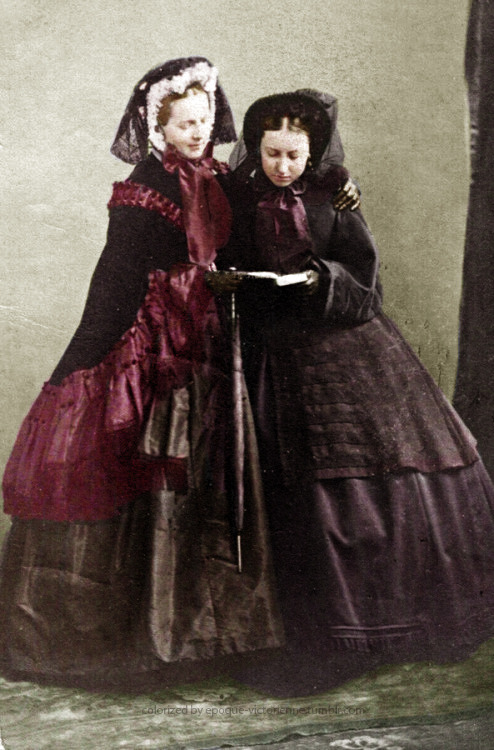
#colorization#colorized photo#victorian#colorized#1860s#Princess Helena#Queen Marie Henriette of Belgium
5 notes
·
View notes
Video
youtube
Henrietta Maria with Elena Maria Vidal - Plotlines
0 notes
Text


The Wedding of Charles, Prince of the Isle & Infanta Maria Christina of Selvadorada
read about their wedding below!
The wedding of the Prince of the Isle, heir to the Windenburg Throne, was destined to be one of the largest royal events of the century. The arrival of the beautiful Infanta attracted a crowd of thousands at the San Myshuno docks. The Infanta was escorted by the Prince of the Isle and her family including the King and Queen of Selvadorada. The Earl and Countess of Blythe, Charles' uncle, and aunt, hosted a banquet at Ely House that night in honor of the Selvadoradian Royal Family.
The next day, the Selvadorian Royal Family was escorted in a royal procession to San Myshuno Palace by the Prince of the Isle. The Infanta met Queen Mary II for the first time at the Palace and was instantly charmed by her kindness. While at the San Myshuno Palace, the bride and groom were given wedding gifts by the Lord Mayor of San Myshuno and other senior government officials. Later that night, the Queen hosted a banquet at the Palace. Following the banquet, the guests went into the gardens where they watched fireworks being displayed. The fireworks were green and gold, and red and white, which represented the flags of Selvadorada and Windenburg.
On August 8th, 1863, Charles and Maria Christina were wed at the St.Bartholomew Cathedral. The bride was attended by seven bridesmaids, all being members of her husband's family, including Princess Francesca of Tartosa, Princess Maria Anna of Tartosa, Princess Helene of Brindleton, Princess Feodora of Brindleton, Lady Henriette Penrose, Lady Georgiana Penrose, and Lady Beatrice Statford. The public Peteran wedding ceremony was performed by the Archbishop of San Myshuno, while a private Jacoban ceremony was held at the San Myshuno Palace. The ceremony at the Cathedral was a grand affair, with over 700 guests in attendance. The wedding was mostly attended by courtiers and members of the bride and groom's family, with little foreign royalty invited.
The Queen hosted a large wedding breakfast at San Myshuno Palace followed by a ball held in the evening. Selvadoradian flags decorated the streets of San Myshuno and Windenburg, and free bread was distributed to the masses in celebration. Following the wedding, banquets and balls were held every night for a week straight to honor the royal couple. In particular, the Duke and Duchess of Montclair hosted a Georgian-themed costume ball which the entire court attended. Infanta Maria Christina dressed up as her husband's ancestor, Leilani, Princess of the Isle. Unfortunately, the costume would prove to be a good fit as Leilani and Maria Christina would both die in childbirth before ever becoming queen.
After a week of festivities, the couple left San Myshuno and spent their honeymoon at Witham Castle. The couple remained at the castle for two weeks before returning to San Myshuno where they would set up residence at Honey House.
#statfordlegacy#sims4#sims#legacy#royallegacy#royalty#ts4 royals#ts4#ts4 royal#ts4 legacy#extras#sims historical#ts4 history#sims 4 victorian#victorian ts4#victorian sims#victorian sims 4
59 notes
·
View notes
Text
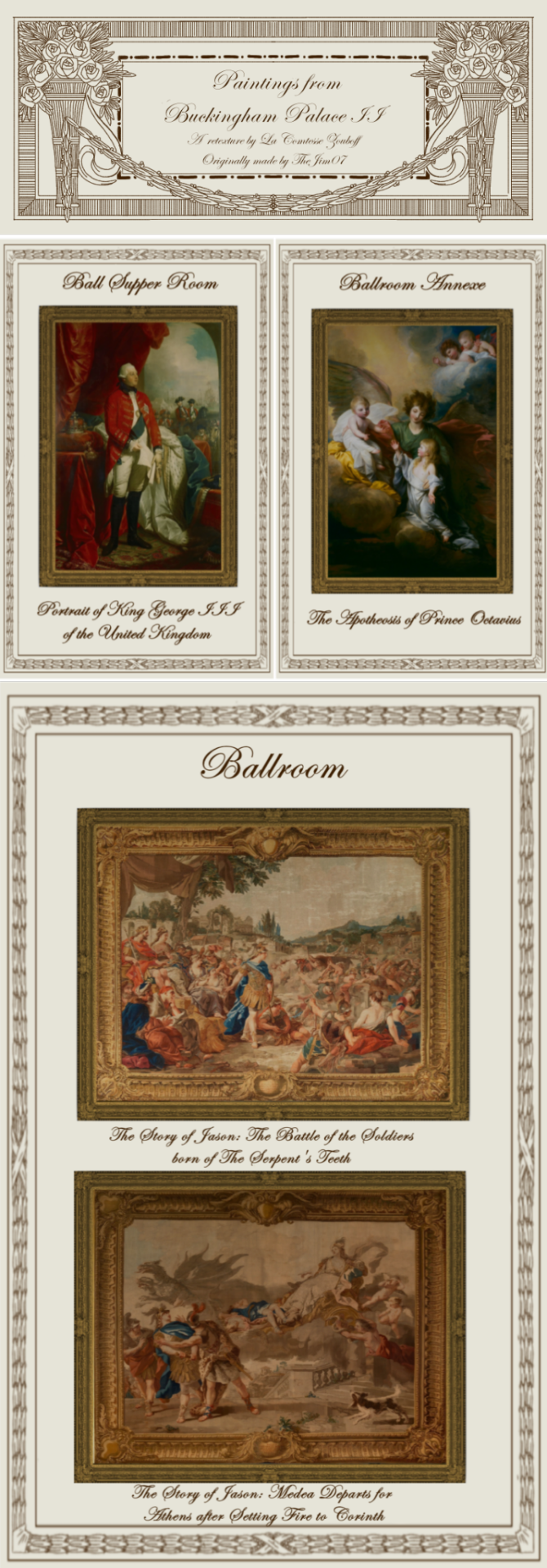
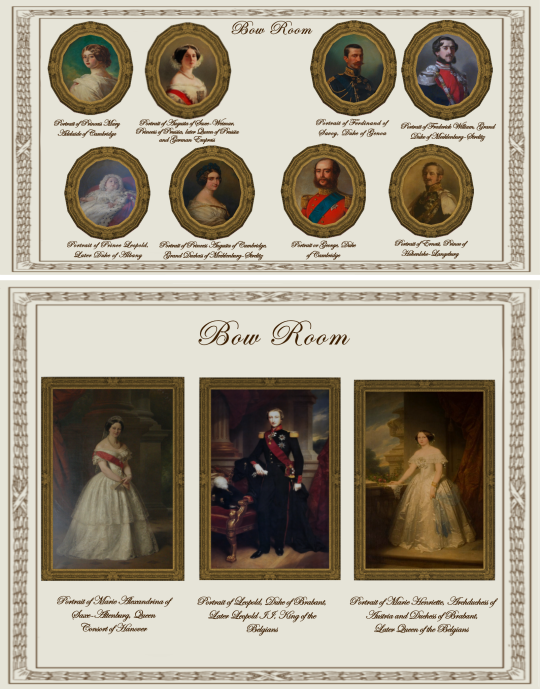
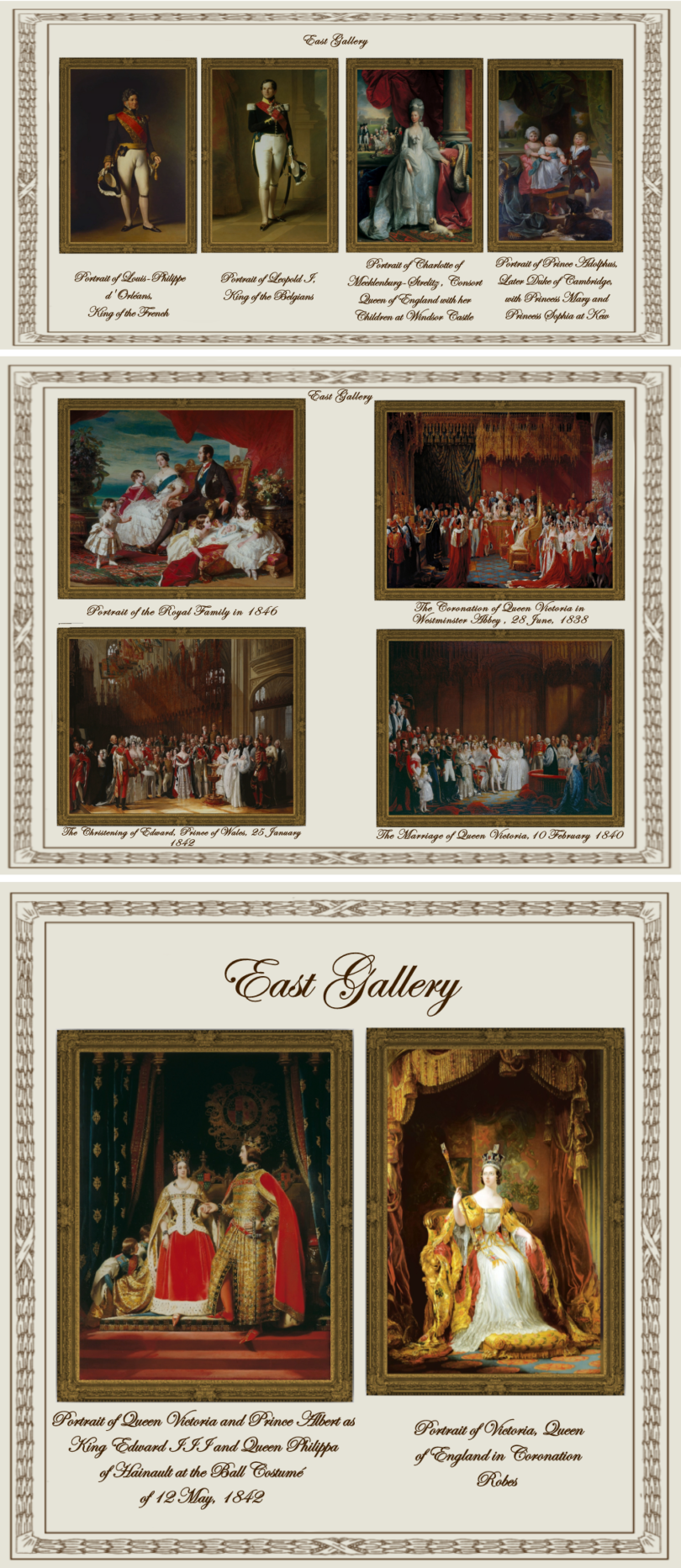
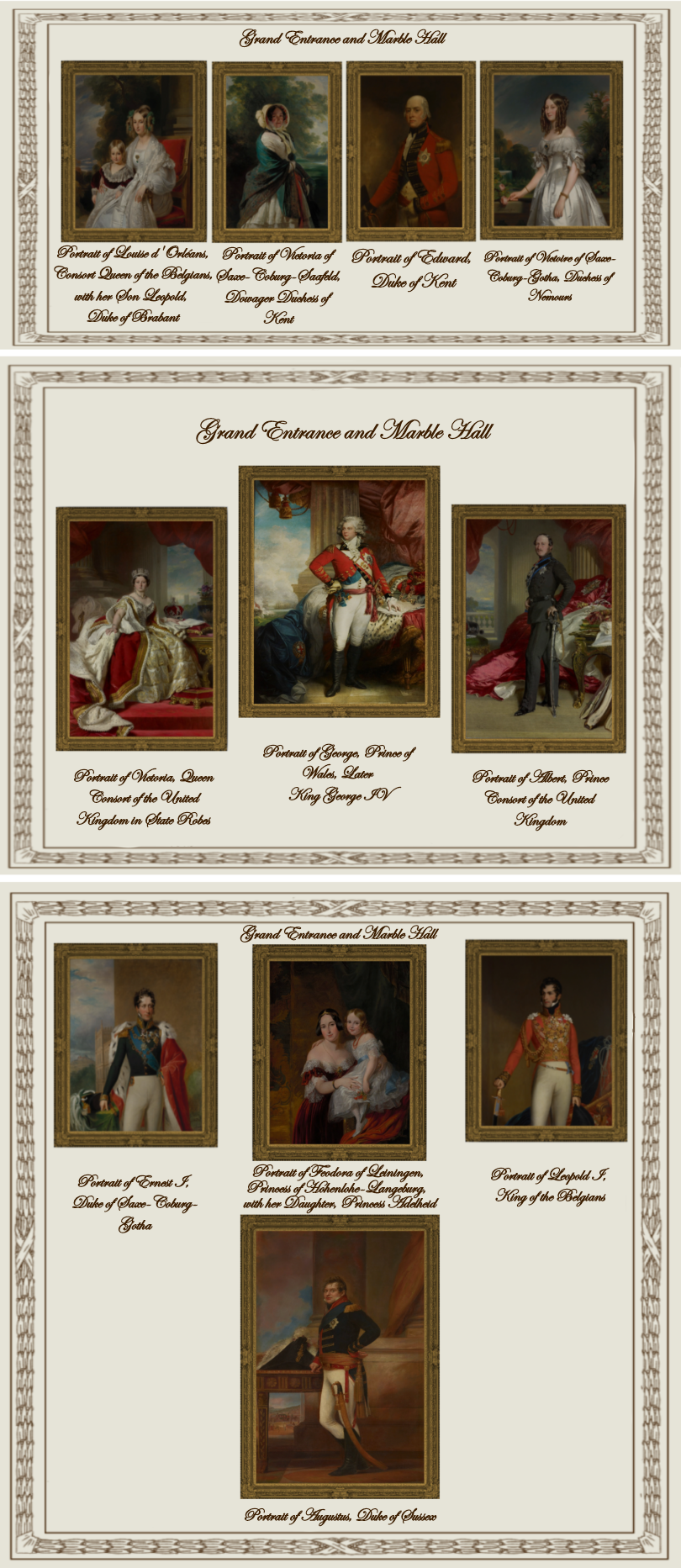

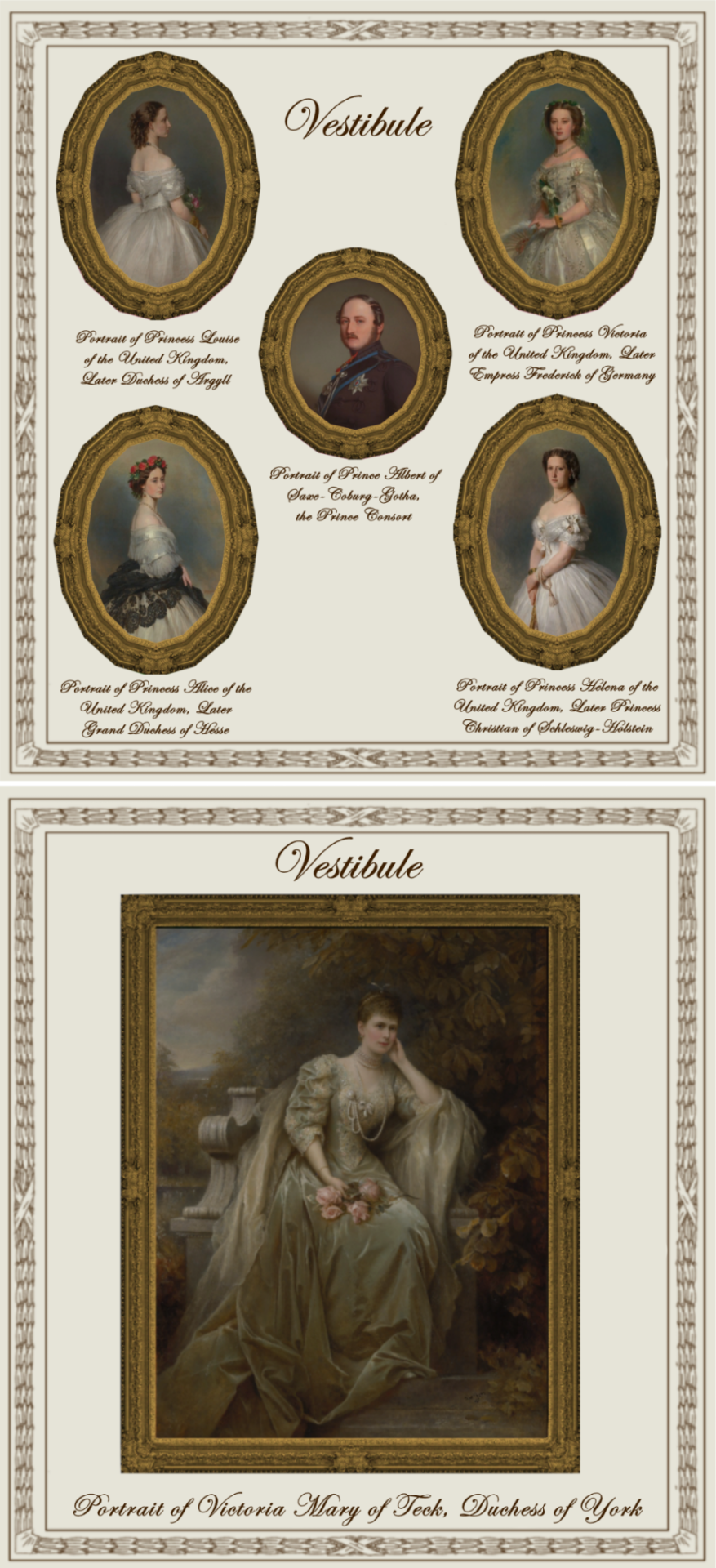
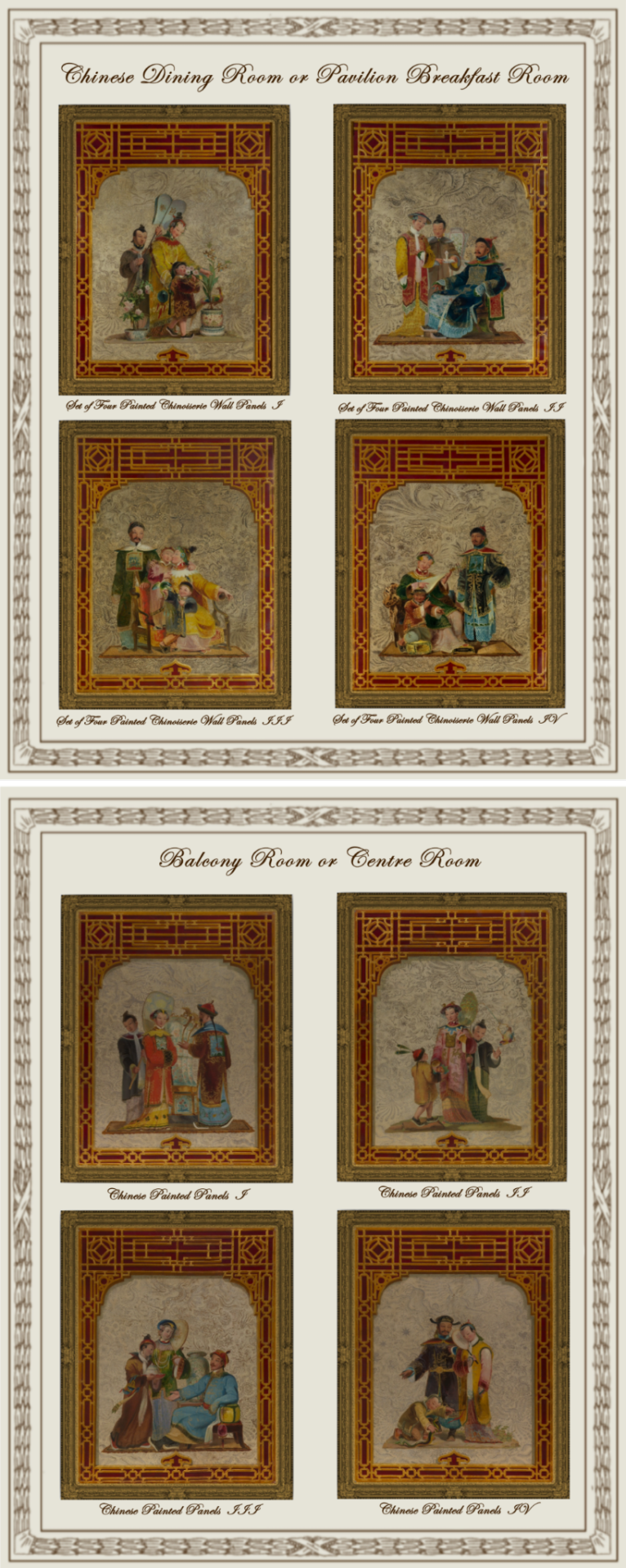

Paintings from Buckingham Palace: part II
A retexture by La Comtesse Zouboff — Original Mesh by @thejim07
Spread among 13 occupied and historic royal residences in the United Kingdom, the collection is owned by King Charles III and overseen by the Royal Collection Trust. The British monarch owns some of the collection in right of the Crown and some as a private individual. It is made up of over one million objects, including 7,000 paintings, over 150,000 works on paper, this including 30,000 watercolours and drawings, and about 450,000 photographs, as well as around 700,000 works of art, including tapestries, furniture, ceramics, textiles, carriages, weapons, armour, jewellery, clocks, musical instruments, tableware, plants, manuscripts, books, and sculptures.
Some of the buildings which house the collection, such as Hampton Court Palace, are open to the public and not lived in by the Royal Family, whilst others, such as Windsor Castle, Kensington Palace and the most remarkable of them, Buckingham Palace are both residences and open to the public.
About 3,000 objects are on loan to museums throughout the world, and many others are lent on a temporary basis to exhibitions.
-------------------------------------------------------
The second part includes paintings displayed in the Ball Supper Room, the Ballroom, the Ballroom Annexe, the Bow Room, the East Gallery, the Grand Entrance and Marble Hall, the Minister's Landing & Staircase, the Vestibule, the Chinese Dining Room and the Balcony Room.
This set contains 57 paintings and tapestries with the original frame swatches, fully recolourable. They are:
Ball Supper Room (BSR):
Portrait of King George III of the United Kingdom (Benjamin West)
Ballroom (BR):
The Story of Jason: The Battle of the Soldiers born of The Serpent's Teeth (the Gobelins)
The Story of Jason: Medea Departs for Athens after Setting Fire to Corinth (the Gobelins)
Ballroom Annexe (BAX):
The Apotheosis of Prince Octavius (Benjamin West)
Bow Room (BWR):
Portrait of Princess Mary Adelaide of Cambridge (William Corden the Younger)
Portrait of Princess Augusta of Cambridge, Grand Duchess of Mecklenburg-Strelitz (Alexander Melville)
Portrait or George, Duke of Cambridge (William Corden the Younger)
Portrait of Frederick William, Grand Duke of Mecklenburg-Strelitz (Franz Xaver Winterhalter)
Portrait of Augusta of Saxe-Weimar, Princess of Prussia, later Queen of Prussia and German Empress (Franz Xaver Winterhalter)
Portrait of Prince Leopold, Later Duke of Albany (Franz Xaver Winterhalter)
Portrait of Ernest, Prince of Hohenlohe-Langeburg (Franz Xaver Winterhalter)
Portrait of Ferdinand of Savoy, Duke of Genoa (Eliseo Sala)
Portrait of Marie Alexandrina of Saxe-Altenburg, Queen Consort of Hanover (Carl Ferdinand Sohn)
Portrait of Leopold, Duke of Brabant, Later Leopold II, King of the Belgians (Nicaise de Keyser)
Portrait of Marie Henriette, Archduchess of Austria and Duchess of Brabant, Later Queen of the Belgians (Nicaise de Keyser)
East Gallery (EG):
Portrait of Leopold I, King of the Belgians (Franz Xaver Winterhalter)
Portrait of Victoria, Queen of England in Coronation Robes (Sir George Hayter)
Portrait of Louis-Philippe d'Orléans, King of the French (Franz Xaver Winterhalter)
Portrait of Charlotte of Mecklenburg-Strelitz, Consort Queen of England with her Children at Windsor Castle (Benjamin West)
Portrait of Prince Adolphus, later Duke of Cambridge, With Princess Mary and Princess Sophia at Kew (Benjamin West)
The Coronation of Queen Victoria in Westminster Abbey, 28 June, 1838. (Sir George Hayter)
The Christening of Edward, Prince of Wales 25 January, 1842 (Sir George Hayter)
The Marriage of Queen Victoria, 10 February, 1840 (Sir George Hayter)
Portrait of the Royal Family in 1846 (Franz Xaver Winterhalter)
Portrait of Queen Victoria and Prince Albert as King Edward III and Queen Philippa of Hainault at the Ball Costumé of 12 May, 1842 (Sir Edwin Landseer)
Grand Entrance and Marble Hall (GEMH):
Portrait of Edward, Duke of Kent (John Hoppner)
Portrait of Ernest I, Duke of Saxe-Coburg-Gotha (George Dawe)
Portrait of Victoria of Saxe-Coburg-Saafeld, Dowager Duchess of Kent (Franz Xaver Winterhalter)
Portrait of Albert, Prince Consort of the United Kingdom (Franz Xaver Winterhalter)
Portrait of Victoria, Queen Consort of the United Kingdom in State Robes (Franz Xaver Winterhalter)
Portrait of Louise d'Orléans, Consort Queen of the Belgians, with her Son Leopold, Duke of Brabant (Franz Xaver Winterhalter)
Portrait of Feodora of Leiningen, Princess of Hohenlohe-Langeburg, with her Daughter, Princess Adelheid (Sir George Hayter)
Portrait of George, Prince of Wales, Later King George IV (Mather Byles Brown)
Portrait of Victoire of Saxe-Coburg-Gotha, Duchess of Nemours (Franz Xaver Winterhalter)
Portrait of Augustus, Duke of Sussex (Domenico Pellegrini)
Portrait of Leopold I, King of the Belgians (William Corden the Younger)
Minister's Landing and Staircase (MLS):
Portrait of George, Prince of Wales in Garther Robes (John Hoppner)
The Loves of the Gods: The Rape of Europa (the Gobelins)
The Loves of the Gods: The Rape of Proserpine (The Gobelins)
Vestibule (VL):
Portrait of Prince Albert of Saxe-Coburg-Gotha, the Prince Consort (Unknown Artist from the German School)
Portrait of Princess Alice of the United Kingdom, Later Grand Duchess of Hesse (Franz Xaver Winterhalter)
Portrait of Princess Helena of the United Kingdom, Later Princess Christian of Schleswig-Holstein (Franz Xaver Winterhalter)
Portrait of Princess Louise of the United Kingdom, Later Duchess of Argyll (Franz Xaver Winterhalter)
Portrait of Princess Victoria of the United Kingdom, Later Empress Frederick of Germany (Franz Xaver Winterhalter)
Portrait of Victoria Mary of Teck, Duchess of York (Edward Hughes)
Chinese Dining Room or Pavilion Breakfast Room(CDR):
Set of Four Painted Chinoiserie Wall panels I (Robert Jones)
Set of Four Painted Chinoiserie Wall panels II (Robert Jones)
Set of Four Painted Chinoiserie Wall panels III (Robert Jones)
Set of Four Painted Chinoiserie Wall panels IV (Robert Jones)
Balcony Room or Centre Room (BR):
Chinoiserie Painted Panel I (Robert Jones)
Chinoiserie Painted Panel II (Robert Jones)
Chinoiserie Painted Panel III (Robert Jones)
Chinoiserie Painted Panel IV (Robert Jones)
EXTRAS! (E):
I decided to add the rest of the tapestries from the story of Jason (wich hangs in the Grand Reception Room at Windsor Castle) and (with Jim's permission) added the original mesh for paintings number 2,3,4 & 5 from the Vestibule (seen here and here) wich was never published. These items are:
The Story of Jason: Jason Pledges his Faith to Medea (the Gobelins)
The Story of Jason: Jason Marries Glauce, Daughter of Creon, King of Thebes (the Gobelins)
The Story of Jason: The Capture of the Golden Fleece (the Gobelins)
The Story of Jason: The Poisoning of Glauce and Creon by Medea's Magic Robe (the Gobelins)
Sea Melodies (Herbert James Draper) (made by TheJim07)
-------------------------------------------------------
Found under decor > paintings for:
500§ (BWR: 1,2,3,4,5,6, & 8 |VL: 1)
570§ (VL: 2,3,4 & 5 |E: 5)
1850§ (GEMH: 1 & 3)
2090§ (GEMH: 2,6,7, 9 & 11)
3560§ (GEMH: 4,5 & 10 |BSR: 1 |EG: 1,2,3,4 & 5 |MLS: 1 |BAX: 1)
3900§ (CDR: 1,2,3 & 4 |BR: 1,2,3 & 4 |EG: 10 |VL: 6 |GEMH: 8)
4470§ (MLS: 2 |E: 1)
6520§ (BR 1 & 2| MLS: 3 |EG: 6,7,8 & 9 |BR: 1 & 2 |E: 2,3 & 4)
Retextured from:
"Saint Mary Magdalene" (BWR: 1,2,3,4,5,6, & 8 |VL: 1) found here.
"Sea Melodies" (VL: 2,3,4 & 5 |E: 5)
"The virgin of the Rosary" (GEMH: 1 & 3) found here.
"Length Portrait of Mrs.D" (GEMH: 4,5 & 10 |BSR: 1 |EG: 1,2,3,4 & 5 |MLS: 1 |BAX: 1) found here
"Portrait of Maria Theresa of Austria and her Son, le Grand Dauphin" (CDR: 1,2,3 & 4 |BR: 1,2,3 & 4 |EG: 10 |VL: 6 |GEMH: 8) found here
"Sacrifice to Jupiter" (MLS: 2 |E: 1) found here
"Vulcan's Forge" (BR 1 & 2| MLS: 3 |EG: 6,7,8 & 9 |BR: 1 & 2 |E: 2,3 & 4) found here
(you can just search for "Buckingham Palace" using the catalog search mod to find the entire set much easier!)
Disclaimer!
Some paintings in the previews look blurry but in the game they're very high definition, it's just because I had to add multiple preview pictures in one picture to be able to upload them all! Also sizes shown in previews are not accurate to the objects' actual sizes in most cases.
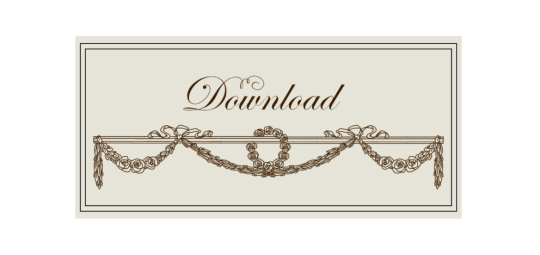
Drive
(Sims3pack | Package)
(Useful tags below)
@joojconverts @ts3history @ts3historicalccfinds @deniisu-sims @katsujiiccfinds @gifappels-stuff
-------------------------------------------------------
#the sims 3#ts3#sims 3#s3cc#sims 3 cc#sims 3 download#sims 3 decor#edwardian#victorian#regency#georgian#buckingham#buckingham palace#wall decor#sims 3 free cc#large pack#this was exhausting
68 notes
·
View notes
Text
My two cents that nobody will read.
I liked the series. It was entertaining and interesting. I know it is called Mary and George. Kudos to them to have the guts to show a queer relationship that shaped English history. But the historian student I once was will not rest.
Mary and George:
not historically accurate: Somerset was dismissed with a letter in 1615 after a quarrel and replaced with George immediately. The Overbury trial sealed his fate.
not expanding correctly on James and George's love: we have proof of that, even flamboyant proof.
Mary's role in his son's life wasn't that active: she had bigger fish to fry with the others and she wasn't a lesbian. We have proof. With all the real lesbians and gays and queers of the period, why do we still need to invent them?
The biggest Queen was the King. In Tony Curran's words. He had surely anxiety problems (with his life how could he not) and he suffered of mood swings.
George had three kids and James wasn't that jealous of his wife: she was regularly at court (I know that the night before the wedding James had a breakdown but they were steady with their affections and he got over it).
George and James were promiscuous but so in love with each other that nobody doubted, not even them. Proof in their letters till James' death and in the reports the Venetian ambassador wrote (you can count on Venice's gossip. It was accurate: the Republic's survival depended on it).
No love letters.
Not showing the secret passage.
Not showing that famous speech comparing them to Jesus and John.
No historically accurate petnames.
Buckingham was incompetent on important matters but not a himbo.
Buckingham didn't kill James: there's no proof about this dark legend. He offered him a cup with some medicine in it according to one report. The king suffered from malaria (or what his doctors thought it was malaria) and George didn't kill him in that way in front of a witness like that.
Not showing the part where he stayed on as Charles I's main advisor for some years before being killed: it almost appears he was killed after the coronation.
Not showing La Rochelle's debacle, his games at the French court with Anne of Austria (we have proof of that) and how unequipped he was against Richelieu.
The fashion wasn't that dark. The show is too dark and Nick would have looked attractive with those beards too. Also Somerset had a wrong beard and all (even the Spanish) didn't have those close cropped beards in that fashion. Were are the flamboyant moustaches?
Not showing Charles' wedding with Henriette Marie of France and the fact that George was probably in that marriage too. In what capacity they only know.
Wrong hair colour for Somerset and for Buckingham. One had red hair, the other auburn. Curly or wavy was the fashion.
Not showing that Buckingham was a good friend of Queen Anne. We have proof in affectionate letters in which she asked him to be "always true" to her husband. George was knighted in her bedchamber and she called him "her dog". She didn't care for Somerset. At all.
Sorry for all of this. I encourage you to watch it but after years I am still waiting for a series that will have the guts to show the historical facts for what they were. They were surely wilder than what we see.
#mary and george#I have nothing against the actors#It was very well acted#good job everyone#still waiting for a James and George though#17th century England
50 notes
·
View notes
Text



Saint Louis Cemetery No. 2
This "second" cemetery represents New Orleans' attempt to keep cholera at bay.
The second-oldest cemetery in New Orleans, this aptly named necropolis was built in response to rampant disease.
Beginning in 1823, following the trends of other urban centers, New Orleans began moving its burial places out of the center of the city and into the outskirts of town in hopes of controlling outbreaks of contagious disease. Dating to the early 19th Century, Saint Louis Cemetery #2 is located just a few blocks from Saint Louis Cemetery #1, the city's oldest cemetery.
Saint Louis Cemetery #2 is the hallowed final resting place of such diverse personalities as privateer Dominique You, potential Catholic Saint Henriette DeLille, and a host of noteworthy New Orleans Jazz musicians.
Both Saint Louis cemeteries were added to the National Register of Historic Places in 1975.
Known for their distinctive above ground burials and particularly lovely monuments, New Orleans' historic cemeteries are all worth exploring, including Saint Louis Cemetery #1 (home to the tomb of "Voodoo Queen" Marie Laveau), the Garden District's Lafayette Cemetery, and the racetrack-shaped Metairie Cemetery.
16 notes
·
View notes
Text






Royal Deaths in History: 19th September
1339 - Go-Daigo, 96th Emperor of Japan.
1356 - Peter I, Duke of Bourbon, killed at the Battle of Poitiers.
1785 - Maria Antonia Ferdinanda of Spain, Queen of Sardinia, consort to Vittorio Amadeo III.
1802 - Luisa of Naples and Sicily, first wife of Ferdinando Ill, Grand Duke of Tuscany.
1895 - Countess Julia Hauke, Princess of Battenberg, morganatic wife of Prince Alexander of Hesse and by Rhine.
1902 - Marie Henriette, Queen of the Belgians, consort to King Leopold II.
11 notes
·
View notes
Text
“I think there was some intent behind Charlotte because of the Princess Royal pattern (as I pointed out yesterday) but I’m not sure how much intent there was. We know that Kate is a great student of history/history of art so she absolutely would have picked up on the Princess Royal pattern, the same way she understood the significance of George for a heir.”
There is no Princess royal pattern unless you mean the number of royal ladies, married or blood born, with the name Charlotte.
Princess Royal title came into the UK monarchy with the restoration when having spent many years at the French court, the restored Charles 2 copied the French tradition of having the eldest daughter of the Monarch given that title. The French equivalent was/ is Madame Royale.
To that end, we’ve only had 7 Princess Royals and all have different names:
Princess Mary Henriette Stuart (b. 1642)
Princess Anne, Princess of Orange (b. 1734)
Princess Charlotte Augusta Matilda (b. 1766)
Princess Victoria Adelaide Mary Louise (b. 1840)
Princess Louise Victoria Alexandre Dagmar (b. 1867)
Princess Mary Alexandra Alice Mary ( b. 1897)
Princess Anne Elizabeth Alice Louise (b. 1950)
If you are going to speak to royal names within the UK monarchy that have significance and are used more often and for much longer by the royals then you’d pick William, Mary, Margaret, Henry, Richard, Catherine ( whichever spelling K or C) and Edward.
Some names were so commonly used that it was inevitable that royals would eventually be given the names eg Richard and Elizabeth.
Charlotte, Caroline, George and Louis came in with the Hanoverians in 1714 when Georg Ludwig, anglicised to George Louis became the first Hanoverian King of England. All 4 are German names or in origin, and were not a thing until the Hanoverians.
The habit of keeping the same names in the family came in with the Hanoverians, but it wasn’t cemented until Victoria became Queen and mandated all her future descendants incorporate Albert or Victoria into their names to keep them alive. That request was broken for those generations born after her death though we are seeing a mini revival with Elizabeth.
********************
You’ve missed the point of the Princess Royal pattern entirely, despite writing it out.
Princess Mary Henriette Stuart (b. 1642)
Princess Anne, Princess of Orange (b. 1734)
Princess Charlotte Augusta Matilda (b. 1766)
Princess Victoria Adelaide Mary Louise (b. 1840)
Princess Louise Victoria Alexandre Dagmar (b. 1867)
Princess Mary Alexandra Alice Mary ( b. 1897)
Princess Anne Elizabeth Alice Louise (b. 1950)
Princess Charlotte Elizabeth Diana (b. 2015, assumed)
I can’t tell if you’re being deliberately obtuse or if you’re so focused on historical precedence that this is legitimately going over your head. It feels like you’re trolling me and I don’t care for it.
17 notes
·
View notes
Text

Princess Marie-José Charlotte Sophie Amélie Henriette Gabrielle of Belgium, later Queen consort of Italy
Belgian vintage postcard
#tarjeta#postkaart#sepia#sophie#carte postale#belgian#charlotte#ansichtskarte#amlie#gabrielle#briefkaart#photo#photography#consort#postal#postkarte#italy#vintage#henriette#belgium#marie#queen#postcard#historic#amélie henriette gabrielle#later#princess#ephemera#marie-josé
7 notes
·
View notes
Text

Portrait of Queen Henrietta Maria
Artist: Anthony van Dyck (Flemish, 1599-1641)
Henrietta Maria of France (25 November 1609 – 10 September 1669) was Queen of England, Scotland and Ireland from her marriage to King Charles I on 13 June 1625 until Charles was executed on 30 January 1649. She was mother of his sons Charles II and James II and VII. Under a decree of her husband, she was known in England as Queen Mary, but she did not like this name and signed her letters "Henriette" or "Henriette Marie".
#portrait#queen#england#henrietta maria of france#woman#landscape#anthony van dyck#flemish painter#queen of england#17th century england#british royals#history
8 notes
·
View notes
